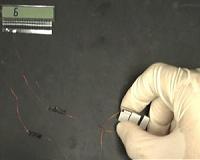 |
Raleigh NC (SPX) Apr 08, 2011 Researchers have long known that landfills produce methane, but had a hard time figuring out why - since landfills do not start out as a friendly environment for the organisms that produce methane. New research from North Carolina State University shows that one species of microbe is paving the way for other methane producers. Specifically, the researchers found that an anaerobic bacterium called Methanosarcina barkeri appears to be the key microbe. "Landfills receive a wide variety of solid waste, and that waste generally starts out with a fairly low pH level," says Dr. Francis de los Reyes, an associate professor of civil engineering at NC State and co-author of a paper describing the research. "The low pH level makes it difficult for most methanogens - methane-producing organisms - to survive. We started this project in hopes of better understanding the mechanism that raises the pH level in landfills, fostering the growth of methanogens." What the researchers found was M. barkeri - a hearty methanogen that can survive at low pH levels. M. barkeri consumes the acids in its environment, producing methane and increasing the pH levels in its immediate area. This, in turn, makes that area more amenable for other methanogens. As moisture leaches through the landfill, it disseminates those high pH levels - making other parts of the landfill habitable for M. barkeri and other methane-producing microbes. M. barkeri then moves in and repeats the process, leaving neutral pH levels - and healthy populations of other methanogens - in its wake. Since M. barkeri and its methanogen cousins produce large quantities of methane, and methane is a powerful greenhouse gas, this could be bad news for the environment. But not necessarily. Methane can be, and often is, collected at landfill sites and used for power generation. Furthermore, methanogens break down solid waste as they go, compacting it so that it takes up less space. "The research community can use our findings to explore ways of accelerating the methane-generation process," de los Reyes says, "creating methane more quickly for power generation, and making additional room in the landfill for waste disposal." The paper, "Effect of Spatial Differences in Microbial Activity, pH, and Substrate Levels on Methanogenesis Initiation in Refuse," will be published in the April issue of Applied and Environmental Microbiology. The paper was co-authored by Dr. Bryan Staley, who did the work while a Ph.D. student at NC State; de los Reyes; and Dr. Morton Barlaz, professor and department head of civil, construction and environmental engineering at NC State. The research was funded by Waste Management, Inc. and the Environmental Research and Education Foundation.
Share This Article With Planet Earth
Related Links North Carolina State University Powering The World in the 21st Century at Energy-Daily.com
 First Practical Nanogenerator Produces Electricity With Pinch Of The Fingers
First Practical Nanogenerator Produces Electricity With Pinch Of The FingersAnaheim CA (SPX) Apr 05, 2011 After six years of intensive effort, scientists are reporting development of the first commercially viable nanogenerator, a flexible chip that can use body movements - a finger pinch now en route to a pulse beat in the future - to generate electricity. Speaking at the 241st National Meeting and Exposition of the American Chemical Society, they described boosting the device's power output b ... read more |
|
| The content herein, unless otherwise known to be public domain, are Copyright 1995-2010 - SpaceDaily. AFP and UPI Wire Stories are copyright Agence France-Presse and United Press International. ESA Portal Reports are copyright European Space Agency. All NASA sourced material is public domain. Additional copyrights may apply in whole or part to other bona fide parties. Advertising does not imply endorsement,agreement or approval of any opinions, statements or information provided by SpaceDaily on any Web page published or hosted by SpaceDaily. Privacy Statement |